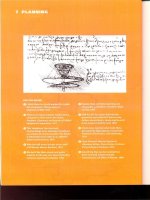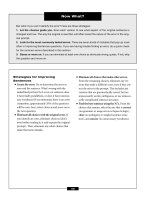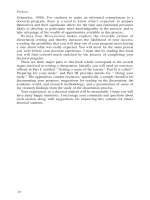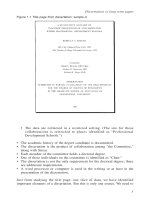Writing your doctoral dissertation - part 4 potx
Bạn đang xem bản rút gọn của tài liệu. Xem và tải ngay bản đầy đủ của tài liệu tại đây (193.59 KB, 5 trang )
Dissertation vs long term paper
10
Table 1.1 A comparison of term papers and dissertations
11
2 Jumping through Hoops, Going on a
Journey
Personal Metaphors for the Process
Successfully completing the dissertation process brings enormous exhilaration!
The deeper your education, the more it will change you. (That’s why it’s so
important to choose carefully what you study and with whom.)
(Booth et al., 1995, p. 9)
When we think about “writing a dissertation” we may envision a person
seated at a computer for long hours, creating hundreds of pages of text,
surrounded by stacks of books and documents. While this is an appropriate
image, it clearly does not capture the totality of the experience. In fact, it
represents only a small part, perhaps 10 per cent of all that goes into writing
the dissertation. Many who have gone through the process comment that only
those who have been there could understand what it’s like. To facilitate your
understanding, we will look at the metaphors which pepper the conversations
of doctoral students.
Metaphors for Dissertation Writing
Dissertation writers frequently describe the process through powerful images
and metaphors. They vividly convey the intensity of the experience and the
strong emotions—positive and negative—involved in the process. Some
consider the process to be much like a Byzantine maze. This suggests there
are many paths, with high bushes separating them, yet no maps, clues, or
knowledgeable guides to lead from entrance to exit. A candidate may go on
seemingly endless treks, never confident of finding the way out.
Others talk of all the hurdles to be mounted or all the hoops to jump through.
They seem to connect dissertation writing with competitive races where there
are numerous fixed, human-created obstacles which the participants need to
mount successfully. The hurdles are strategically placed obstacles, making the
path to be traveled intentionally difficult. The hoops may change in size and
location. Implicitly, too, there is one predetermined, acceptable goal and route
to be followed. Malevolence is inherent in this model, suggesting that those in
charge intentionally seek to make the process difficult. Those who are strong-
willed, stubborn, and tenacious will prevail and succeed.
Jumping through hoops
12
Mountain climbing, running the rapids, and running a marathon are also
frequent analogies. While these are challenging physical exercises much like
mounting hurdles, they differ in that the challenges are naturally occurring, not
intentionally created. There is a sense that the individual is testing and
challenging herself or himself to try more difficult activities, seeking to enhance
his or her record. In these metaphors there is neither the necessity for competition
with others nor a malevolent connotation. The individual who succeeds in
climbing the mountain is pleased at having met a self-established challenge.
Others talk about the dissertation process as a game. They are focusing on
the fixed end, and the identification of winners and losers in the process. In
addition, there is always the possibility of playing another round with new
winners. Frequently there is allusion to the fact that although this is a game,
the rules either were not explained at the outset or constantly change. In this
metaphor, the dissertation writer considers herself or himself to be a victim,
subject to others’ rules, with no power or control.
Kelly A.Clark, a doctoral student at the University of Vermont, while attending
a session of the Ethnography Conference at the University of Pennsylvania in
1997, created (along with several other conference co-attenders) a Chutes and
Ladders drawing to convey her sense of the complexity of the process (see Figure
2.1). They considered the dissertation process to be an uphill battle. There are
numerous ladders which represent the support from faculty advisors and peers.
The chutes represent the gate-keepers, and distractions from life that sidetrack
their progress. For those who persevere, there is the oral defense and then a time
to celebrate. Although children are known to play Chutes and Ladders for hours,
the connection with the dissertation process is perhaps a cynical one, suggesting
that the dissertation is one more of life’s “games.”
Another description of the doctoral process uses a gardening comparison.
In this model, the doctoral candidate focuses on the slow growth process from
seed to flower: the need for patient weeding, fertilizing, watering, and constant
monitoring to adjust for unpredictable factors such as weather conditions and
the speed of seed germination. The reaped flowers or fruit reward the intense
attention to the garden. In this model, the doctoral candidate may select the
seeds to plant, based, for example, on knowledge about the climate and soil
conditions. Then the candidate takes responsibility for constantly monitoring
their progress, and nurturing the growth of the seedlings to flowers or fruit.
Additional resources may enhance the quality of the flowers or fruit, or protect
them from insects or unexpected weather conditions. From this process, the
gardener/dissertation writer becomes more knowledgeable and more adept at
growing/writing. This metaphor suggests an optimistic stance on writing a
dissertation, viewing it as an intellectual and emotional growth process with a
positive, predictable outcome and little mental contribution.
Other metaphors include:
A coming of age experience A guide brings me through a brutal, mind-
blowing experience, resulting in my viewing the world with new lenses, ready
to face new challenges.
Figure 2.1 Chutes and Ladders: the doctoral dissertation process
Soure: Kelly A.Clark
Jumping through hoops
14
A train ride, a trip, a journey An exploration of new terrain, having new
experiences and becoming exhilarated and exhausted in the process.
An exercise, a war, a battle An on-going conflict with no clear indication
of appropriate strategies or predictable outcomes.
A hazing experience A humiliating experience to be endured.
A birthing event A process filled with anticipation, tension of the unknown,
and ultimately, a new life along with the possibility of post-partum
depression.
A blind person An individual stumbling in a room never visited before.
A dance An activity including finding a partner who will lead me because
I’m never sure what the next step is, but know I need to depend on my partner
(chair) to learn and complete the dance.
While the metaphors all conjure up different images, there are striking
commonalities between them. They are all physical activities accompanied
by significant affective dimensions. They are:
• memorable and emotionally complex;
• physically and intellectually challenging;
• dependent on a guide or leader; and
• processes with winners and losers.
These metaphors provide a sense of the range of experiences doctoral candidates
recall. Doctoral students frequently change their metaphors as they progress. It is
not uncommon to share enthusiasm with a student on a jubilant day, and to
discover her or him two weeks later in a confused or frustrated state of mind.
Our understanding of this general range of experiences provides an opportunity
to dig deeper, to get more specific about student experience. As a way to obtain
additional dimensions and a more comprehensive understanding we look in
greater depth at typical doctoral students’ comments.
Reflecting on the Reflections
The metaphors provide important insights in our quest to understand the
doctoral process:
• Writing the dissertation involves exposure to ideas. For some, this is
equated with learning; for others, it engenders a resistant attitude. Students
develop organizational and evaluation skills; students increase the rigor of
their thinking and become committed to lifelong learning; students become









